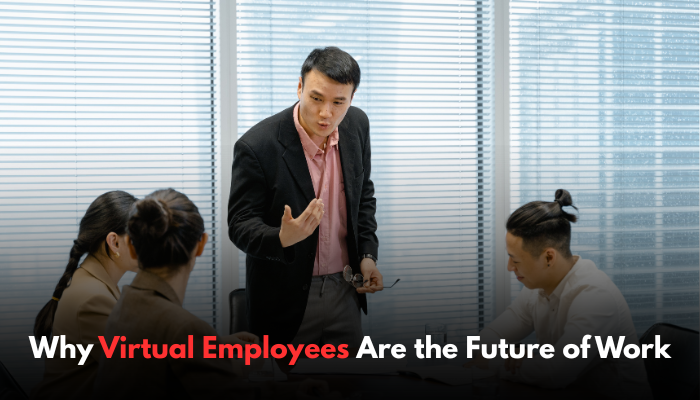A shift is underway not just in where people work, but in how businesses build and scale teams. As global connectivity strengthens and business costs rise, more organizations are rethinking traditional hiring models. The result? A growing reliance on virtual employees.
These professionals work remotely, often from different parts of the world, yet remain fully integrated into a company’s operations. From administrative roles to technical positions, virtual employees are transforming how work gets done.
In this article, we explore the key reasons why virtual employees are poised to define the future of work.
1. Access to a Global Talent Pool
Hiring no longer needs to be limited by geography. With virtual employees, companies can tap into talent from any country, timezone, or culture. This opens the door to specialized skills and diverse perspectives that may not be available locally.
Benefits of global hiring include:
- Easier access to rare or niche skills
- Language and cultural diversity for international markets
- Competitive salaries in regions with lower living costs
- Around-the-clock productivity across time zones
- Faster hiring cycles through global job platforms
With fewer boundaries in recruitment, the best person for the job is now truly within reach.
2. Reduced Overhead and Operational Costs
One of the most attractive aspects of hiring virtual employees is the potential for significant cost savings. Physical offices come with expenses rent, utilities, equipment, and more. Remote teams reduce or eliminate many of these costs.
Companies can save in areas such as:
- Office space and furnishings
- Commuting allowances and parking fees
- On-site amenities and supplies
- Relocation packages for new hires
- Local payroll tax liabilities in some jurisdictions
By redirecting these savings into growth or innovation, companies gain a clear competitive edge.
3. Increased Productivity and Focus
It’s a common misconception that remote workers are less productive. Studies consistently show the opposite. Virtual employees often perform at higher levels due to fewer workplace distractions and more flexible environments.
Key productivity factors include:
- Ability to design a personalized workspace
- Reduced office chatter and interruptions
- No time lost in commuting
- Greater autonomy and trust-based performance
- Customizable work hours aligned with peak energy levels
When people are trusted to manage their time, the quality of their work often improves.
4. Flexibility and Scalability for Businesses
Whether you’re launching a startup or expanding an established business, scalability is crucial. Hiring virtual employees gives companies the ability to scale teams quickly and efficiently without the delays of traditional onboarding or physical relocation.
Companies gain:
- Faster recruitment timelines
- Easier integration into digital workflows
- Flexibility to test new roles or departments
- Ability to scale up or down as demand changes
- Lower risk when exploring new markets or services
This agility is especially important for businesses navigating rapid growth or uncertain market conditions.
5. Access to Specialized Skills On Demand
The future of work demands more than generalists. Many projects require highly specific skills for short periods and this is where virtual employees truly shine. Whether it’s software development, legal research, content writing, or financial analysis, experts are just a click away.
By hiring virtually, you can:
- Bring in temporary specialists without long-term contracts
- Avoid overburdening full-time staff with unfamiliar tasks
- Create agile, project-based teams tailored to current needs
- Leverage freelance or contract experts for one-off initiatives
- Maintain a lean in-house team without sacrificing capability
This model empowers companies to be both efficient and highly skilled.
6. Stronger Employee Retention and Satisfaction
Many virtual employees report higher job satisfaction, which often translates into longer retention. When workers can tailor their work-life balance, avoid daily commutes, and work from comfortable environments, they’re more likely to stay loyal to their employers.
This leads to:
- Reduced turnover costs and hiring disruptions
- Longer knowledge retention within the team
- Stronger organizational culture across time zones
- Improved mental health and job satisfaction
- Better engagement with mission-driven companies
When people feel trusted and supported, they tend to give their best no matter where they work.
7. Environmental Sustainability
There’s another angle to the rise of virtual employees that often goes unnoticed their contribution to environmental goals. Remote work reduces carbon emissions by eliminating daily commutes and reducing office energy consumption.
Sustainable benefits include:
- Lower emissions from transportation
- Reduced demand for urban office space
- Decreased use of single-use office supplies
- Smaller corporate carbon footprints
- Enhanced brand reputation for eco-conscious practices
For businesses striving to meet ESG (Environmental, Social, and Governance) targets, a virtual workforce offers a powerful lever.
8. Better Use of Technology and Collaboration Tools
Adopting a virtual employee model encourages companies to modernize their tech stack. Cloud-based collaboration tools, project management platforms, and communication software become standard and productivity often improves as a result.
Popular tools used by virtual teams include:
- Slack or Microsoft Teams for communication
- Trello, Asana, or ClickUp for task management
- Google Workspace or Office 365 for file sharing
- Zoom or Meet for video conferencing
- Time tracking tools like Hubstaff or Time Doctor
This tech-first approach aligns well with future-ready business models.
9. Round-the-Clock Business Operations
With virtual employees located in different time zones, businesses can now operate 24/7 without overworking local staff. Customer support, order processing, and technical maintenance can continue while your main office sleeps.
This approach is especially effective for:
- E-commerce platforms needing global support
- SaaS companies offering international service
- Digital marketing agencies with worldwide clients
- IT teams managing uptime and server health
- Financial firms covering multiple markets
A global team ensures you’re never truly offline.
10. Future-Proofing Against Disruption
Whether it’s a health crisis, economic downturn, or natural disaster, businesses that rely on virtual employees are inherently more resilient. Remote infrastructure, flexible teams, and decentralized operations enable faster adaptation to change.
Companies that embrace this model:
- Experience fewer workflow disruptions
- Maintain continuity with minimal physical dependencies
- Can shift resources and strategies quickly
- Face lower risks from regional disruptions
- Improve long-term business continuity planning
Virtual work is not just a trend it’s a strategy for surviving and thriving.
Final Thoughts
Virtual employees are not a backup plan they are an evolution of how modern businesses operate. From cost efficiency to greater flexibility and stronger global collaboration, the advantages are clear. By integrating virtual employees into your workforce, you’re not just adapting — you’re positioning your company for long-term success.
If you’re looking to hire virtual employees, Invedus Outsourcing is a trusted partner that provides skilled, dedicated professionals ready to work with your business model. Whether you need administrative support, IT experts, or creative talent, they can help you build a virtual team that delivers results.
Want To Read More Articles? Visit This Website-: theguestblogs.com





